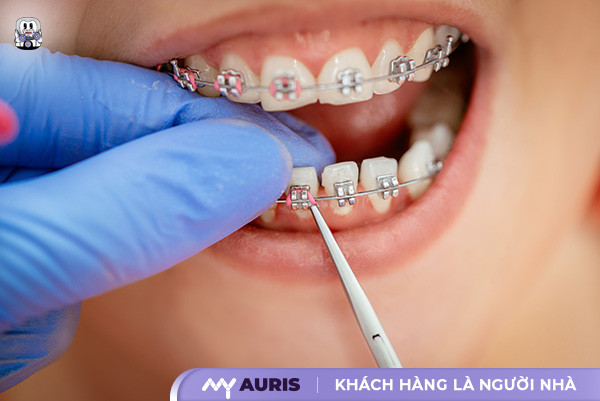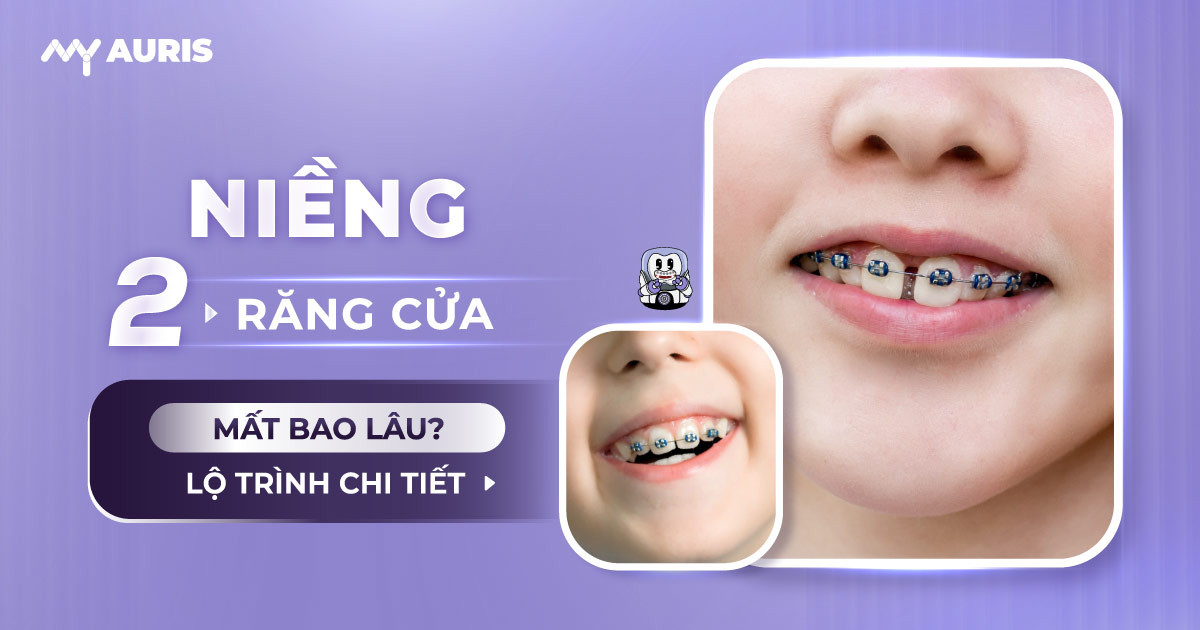Are you looking into front teeth braces? Having straight, even teeth and a radiant smile is the desire of many. Front teeth braces are an effective solution to correct imperfections in the front teeth and improve smile aesthetics. This article will provide useful information about front teeth braces, helping you better understand the process, methods, and important considerations. Let’s learn more to make an informed decision for your oral health. For detailed consultation, you can contact My Auris Dental Clinic.
What are front teeth braces?
Front teeth braces, or anterior orthodontics, is a dental treatment method aimed at improving the position, alignment, and aesthetics of the front teeth. Front teeth are the most important teeth at the front of the jaw, playing a primary role in chewing and smiling. Therefore, straight, even, and beautiful front teeth contribute to a confident and attractive appearance. The main purposes of front teeth braces are:
Improve aesthetics: Create straight, aligned, and tightly closed teeth, bringing a bright and confident smile. This is especially important for those with misaligned, protruding, underdeveloped (underbite), gapped, or crowded front teeth.
Correct malocclusion: In some cases, misaligned front teeth cause malocclusion, affecting chewing function and long-term oral health. Braces help adjust the bite, leading to more efficient chewing.
Enhance oral health: Straight, even teeth are easier to clean, reducing the risk of tooth decay, gingivitis, and other oral diseases.

Common Imperfections in Front Teeth and Effective Treatment Solutions
Braces are a common orthodontic method that helps correct issues such as crooked teeth, overbites, underbites, or malocclusion, resulting in straight, even teeth with a proper bite. Many dental imperfections not only affect the entire arch but are also clearly concentrated in the two front teeth, leading to aesthetic concerns and impacting chewing function. Below are three common conditions:
Misaligned Front Teeth
Misaligned front teeth occur when the two front teeth do not erupt correctly along the dental arch, often overlapping or crowding adjacent teeth. This not only unbalances the overall facial appearance but also severely affects the tearing function of the anterior teeth.
Protruding Front Teeth (Overjet)
Similar to an overbite, protruding front teeth (overjet) describe a condition where the two front teeth excessively protrude forward compared to the other teeth in the arch. If the protrusion is severe, the upper and lower front teeth will not meet properly during chewing, causing difficulty in biting food and reducing facial aesthetics.
Gapped Front Teeth
When the two front teeth are spaced far apart, creating a gap where food can easily get stuck – especially when eating hard foods – it can easily cause gum damage and inflammation. Gapped front teeth also make the smile less harmonious, affecting confidence in communication.
Is Bracing Only 2 Front Teeth Possible?
Is bracing only 2 front teeth an effective solution when the remaining teeth in the arch are relatively even? Many believe that adjusting only slightly misaligned or slightly protruding front teeth is sufficient, however, according to orthodontic specialists, this is not recommended.
The reason is that the dental arch functions as a single unit. When force is applied to just 2 front teeth, the shifting force will affect adjacent teeth, potentially even altering the entire bite. If the bite becomes misaligned, it not only impacts chewing ability but also causes facial imbalance, reducing aesthetic appeal.
Only bracing 2 front teeth while other teeth are not simultaneously adjusted can lead to bite disorders later on. In such cases, the full-arch bracing process will be more complex, require more bracing time and effort, and significantly higher bracing costs.
How Long Does Bracing 2 Front Teeth Take?
The duration for bracing 2 front teeth is not fixed. It depends on several important factors, including:
Degree of Misalignment: If only minor adjustments are needed, such as slightly crooked or rotated teeth, the bracing period can be shorter, only 3-6 months. However, if the misalignment is more severe and requires significant tooth movement, the duration may extend up to 12 months or longer.
Treatment Method: There are various bracing methods, each with different treatment times. Traditional braces (metal braces, ceramic braces) generally take longer than clear aligners like Invisalign. Gold front teeth braces or lingual (behind the teeth) front teeth braces can also affect the duration.
Age and Oral Health Condition: Age influences the speed of tooth movement. Younger individuals typically experience faster tooth movement. Oral health status is also crucial; conditions like gingivitis or tooth decay will affect the treatment process.
Patient Compliance: Adhering strictly to the dentist’s instructions, maintaining thorough oral hygiene, and attending scheduled follow-up appointments will help the bracing process proceed quickly and effectively. Conversely, if the patient is non-compliant, the treatment duration may be prolonged.
Dental Technique: The technique and experience of the orthodontist also play a significant role. An experienced dentist will be able to devise an optimal treatment plan, helping to shorten the bracing time.

Are Front Teeth Braces Painful?
This sensation is often described as a slight soreness or discomfort, rather than a sharp pain. The level of pain varies depending on the individual, the bracing method, and the dentist’s technique.
Typically, the discomfort will gradually subside over time. After a few months, you will become accustomed to the brackets and wires, and the feeling of discomfort will significantly decrease. However, don’t forget to maintain thorough oral hygiene to prevent dental problems that could exacerbate discomfort.
Which is the Most Effective Method for Bracing 2 Front Teeth Today?
Bracing only 2 front teeth cannot actually be done in isolation; it requires comprehensive orthodontic treatment of all teeth in the dental arch to ensure both aesthetic and functional effectiveness. Currently, reputable dental clinics typically apply two popular bracing methods: traditional braces and modern clear aligners.
Both methods offer high effectiveness in treating issues such as overbites, underbites, misaligned teeth, gapped teeth, and crooked teeth. However, clear aligners – especially with Invisalign technology – are considered a superior choice due to several outstanding advantages:
Superior aesthetics: Clear aligners fit snugly over the teeth, making them virtually invisible, which helps you communicate confidently in all situations.
Faster results: Thanks to advanced Invisalign technology, the bracing time is significantly reduced compared to traditional braces.
Easy to remove: Users can remove the aligners themselves for eating or oral hygiene, thereby reducing the risk of tooth decay and gingivitis.
More comfortable to wear: No more rubbing pain from brackets against the lips and cheeks, providing a pleasant experience throughout the treatment process.
Common Front Teeth Problems and Treatment Solutions
Crooked, Gapped, or Crowded Teeth
Crooked, gapped, or crowded front teeth are common issues. Gapped teeth affect aesthetics and can easily trap food, leading to inflammation. Crowded teeth make cleaning difficult, increasing the risk of tooth decay and gingivitis. Crooked teeth affect the bite, causing jaw pain and difficulty chewing.
Solution: Dental treatment, specifically orthodontics (braces), is the most effective way to correct these conditions.
Overbite, Underbite
An overbite (upper front teeth protrude forward) or an underbite (lower front teeth recede inward) not only affects aesthetics but also causes difficulty in chewing and can lead to bite problems.
Solution: Braces are the primary method for correcting overbites and underbites. Depending on the severity, the dentist may recommend full-arch braces or single-arch braces, combined with other measures such as tooth extraction or surgery if necessary.
Tooth Decay, Gingivitis
Poor oral hygiene is the main cause of tooth decay and gingivitis in the front teeth. Tooth decay causes pain, enamel damage, and even tooth loss. Gingivitis causes swelling, redness, and bleeding gums.
Solution: Proper oral care is the most important step. Brush your teeth at least twice a day with fluoride toothpaste, and use dental floss daily to clean between teeth. Regular dental check-ups are essential to detect and treat tooth decay and gingivitis promptly. In severe cases of tooth decay, the dentist may recommend fillings or root canal treatment.
Missing Front Tooth
Missing front teeth due to accidents, severe tooth decay, or other oral diseases cause aesthetic concerns, affect chewing function, and can lead to misalignment of other teeth.
Solution: Depending on the condition of the missing tooth, the dentist may suggest solutions such as dental bridges, implant placement, or dental crowns. Dental crowns can be used to restore damaged front teeth.

Proper Oral Care for Naturally Straight and Beautiful Teeth
This is the most important step. You need to brush your teeth at least twice a day, for about 2 minutes each time. Use a soft-bristled toothbrush and fluoride toothpaste. Brush gently in circular motions, cleaning every tooth surface, including the chewing, inner, and outer surfaces. Don’t forget to brush your tongue to remove bacteria that cause bad breath.
Dental floss helps remove plaque and food particles from areas your toothbrush can’t reach, between your teeth. Use dental floss once a day, gently sliding it between your teeth, avoiding damage to your gums.
Antiseptic mouthwash helps eliminate remaining bacteria after brushing and flossing. However, you should not overuse mouthwash as a substitute for brushing and flossing.
Regular dental check-ups every 6 months are extremely necessary. Your dentist will examine your oral health, detect and treat problems like tooth decay, gingivitis, and periodontal disease early, helping you prevent dangerous oral health conditions.
Limit sweets, sugary foods, and starches. Increase your intake of green vegetables, fruits, and foods rich in calcium and vitamin D to help strengthen your teeth. Drinking plenty of water also helps maintain moisture in your mouth, preventing dry mouth.
If you are wearing braces, oral care needs to be even more meticulous. You need to use a specialized toothbrush for braces, soft dental floss, and antiseptic mouthwash. Clean your brackets and wires carefully to prevent food from getting trapped and causing inflammation. Don’t forget to visit your dentist for regular check-ups and professional dental cleaning.





